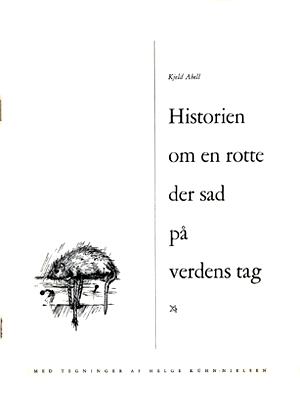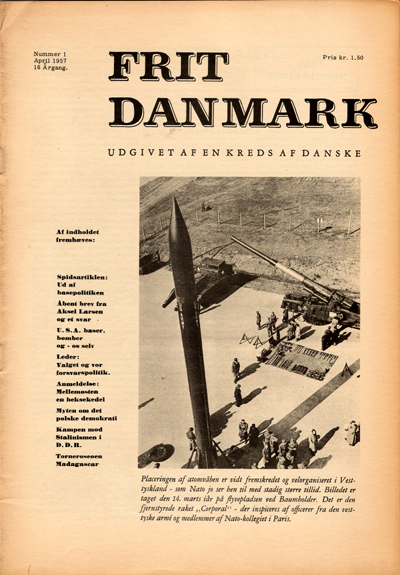The Danish Peace Academy
Holger Terp: Danish Peace History
Working paper 1
Flexible double standards policies during the cold war
 |
 |
|
The Danish Communist magazine
the Time, June 1952. The Danish Communists were against NATO and
against the militarization of Denmark during the Cold War. Artist
unknown.
|
 |
The cold war in Denmark is the subject of both heated political debates and historical research. The main Danish contributions to the iron curtain of the cold war were the membership of NATO and the American Thule Air Base154.
This goes back to the second world war: 'Bowman’s territorial group registered the one immediate impact of the War and Peace Studies upon evolving foreign policy. On March 17, 1940, the Council submitted a memo, “The Strategic Importance of Greenland,” advising that, since the Danish outland was properly a part of the Western Hemisphere, it should be covered by the Monroe Doctrine. President Roosevelt promptly invited Bowman for a discussion at the White House, and one day after Nazi Germany occupied Denmark in April, Roosevelt declared American policy along the lines proposed by the Council group, including the intent to establish military bases in Greenland'. Source: CFR: Continuing the Inquiry, War and Peace. http://www.cfr.org/about/history/cfr/war_peace.html
According to a study by the Norwegian professor Geir Lundestad, “it is impossible to study American-Danish relations without bringing in Greenland”155; and the Danish governments top secret allowances of US nuclear weapons in Greenland, contradicting the official security policy of no foreign bases and no nuclear weapons on Danish territory.
This was made possible by a little known Danish-American agreement, dated January 27, 1950, which article III stated, that “all military related information between the two governments should be classified”156.
A new treaty on general security of military information was made February 27, 1981 after Scandinavian peace researchers discovered that the American archival rules were more liberal than their own countries restricted rules157.
The much debated anthology: “Grønland Middelhavets Perle : Et indblik i amerikansk atomkrigsforberedelse” from 1983 is one of many samples of peace researchers who were looking too close into the politicians cards.
The American's activities in Greenland and Denmark have been investigated by the Danish Institute of International Affairs, Greenpeace, Hans M. Kristensen and others, though not all yet has been said in this matter, neither by the historians nor the courts158.
The American military facilities in the Faroe Islands during and after the cold war needs also a closer look.
After Denmark in the spring of 1949 became a member of NATO two communistic inspired peace organisations were created: the Danish Peace Conference and the Danish chapter of the international les Partisans de la Paix159. From March 1950 the Danish Peace Supporters collected signatures to the World Peace Council’s Stockholm-appeal against nuclear weapons; while the Danish Peace Conference during the first part of the cold war in the 1950s held three conferences to get the labour movement into organised peace work with little success. Other new initiatives were the Committee on a independent foreign policy established by the magazine “Frit Danmark”, Danish chapters of the One World Movement and Federation demokratique internationale des femmes. The Federation demokratique internationale des femmes held an international congress in Copenhagen at the same time as the new Danish constitution entered into force 1953.
In May 1951 two well-known Danish women, the editor of the magazine "Frit Danmark / Free Denmark", Kate Fleron and chief librarian Ida Bachmann was with an international delegation of women in North Korea. And appalling is their reports submitted in later meetings on the horrors of war brought upon the Korean people. The Commission of Inquiry and the journey was organized by the Women's Democratic World Federation.
A good candidate for the first protest song against nuclear weapons is the American journalist Vernon Partlow’s Atomic Blues or Talking Atomic Blues, written in 1945, published and recorded in 1950 by Sam Hinton. During the Newport 1963 Folk Festival Sam Hinton made a new recording of the song. In the autumn of 1953 Atomic Blues was translated into Danish and performed by actress and jazz singer Lise Ringheim (1926-1994), together with composer Børge Roger-Henrichsen (1915-1989) in a Saturday Martine for the Partisans for peace in the Hall of the Student Union in Copenhagen. Atomic Blues was later published in the magazine Dialog in November 1953.
Danes protested against West Germany's admission in NATO.
The radical liberal politican Else Zeuthen (1897-1975) had became member of the executive committee of the Women’s International League for Peace and Freedom in 1946. In 1954 Zeuthen was elected chairwomen of the organisation; also she had become member of the parliament in 1953160.
After the Soviet invasion of Hungary in 1956 the umbrella organisation Danish Refugee Council was created for the Danish aid and refugee organisations161.
Both official and private intelligence services surveyed and recorded opposition groups as well as peace groups during and after the cold war; contradicting official government policy statements of March 5, 1947, November 13, 1952 and September 30, 1968 on no intelligence filings of “lawful political activities”. As one of many protests against the intelligence services huge files on political active persons, the Zealand Committee against the Card Files was established in 1965162. The Danish intelligence services activities needs more research163.

Notes |
154 The concept iron curtain is traced to the beginning of World War One, where the Swedish politician Hjalmer Branting uses the concept to describe Germany during the mobilising in 1914: “The iron curtain went down around the great military power at the same moment Germany was declared in a state of war” – a kind of preparation for mobilisation. At once the isolation became complete”. News were censured by civilian and military authorities and nobody gets to know what is happening outside the borders of the realm. Though propaganda the citizens are given the impression that they are surrounded by enemies who aspire their lives and during these conditions they must guard themselves. It is only from this psychological chance, continues Branting, this mass psychosis, that the sudden change (the war fever) can come”. Hjalmar, Hjalmer: Arbetarklassen och världssläget. Stockholm, 1915. Quoted from: Boje, Andreas: Det tyske Socialdemokrati før og under Verdenskrigen, 1916 p. 92.
155 Lundestad, Geir: America, Scandinavia and the Cold War 1945-1949. Oslo University Press, 1980. p. 1.
156 Dansk-Amerikansk overenskomst om gensidig bistand på forsvarets område.
'Artikel III: Hver regering vil træffe sådanne sikkerhedsforanstaltninger, hvorom de to regeringer måtte træffe aftale i hvert enkelt tilfælde, for at hindre, at militære artikler, ydelser eller oplysninger af særlig (klassificeret) fortrolig karakter, leveret af den anden regering ifølge nærværende overenskomst, røbes eller prisgives'. Udenrigsministeriet: Dansk udenrigspolitik 1948-1966, II Bilag pp. 436-440.

157 Headquarters United States European Command: Index of International Agreements, 1989.
158 The Danish Institute for International Affairs has been tasked by the Danish government to prepare a study (white paper) on the security policy situation of Denmark during the Cold War 1945-1990. The white paper is expected in 2004.
Brøsted, Jens: Thule – Fangerfolk og militæranlæg : En retslig historisk undersøgelse af Thule basens anlæggelse, Thules flytning og befolkningens erstatningskrav / Jens Brøsted ; Mads Fægteborg, 1978.
DUPI: Grønland under den kolde krig : Dansk og amerikansk sikkerhedspolitik 1945-1968, 1997. Lidegaard, Bo: I Kongens navn : Henrik Kauffmann i dansk diplomati 1919-58, 1996.
Lidegaard, Bo: Jens Otto Krag 1914-1961, Vol 1. 2001.
Mouritzen, Hans: Denmark in the post-cold war era : The salient action spheres. Pp 33-51. In: Danish foreign policy yearbook, 1997.
Mourtizen, Hans: Finlandization: Towards a general theory of adaptive politics. Aldershot: Ashgate, 1988.
Keylor, William R.: The twentieth-century world: An international history
Oxford: Oxford University Press, 1984.
The following volume is being translated into English:
Villaume, Poul: Allieret med forbehold: Danmark, NATO og den kolde krig : Et studie i dansk sikkerhedspolitik 1949-1961. Eirene, 1997.
159 Fredens Tilhængere i Danmark and Dansk Fredskonference. Jørgensen, Jesper: Fredens Tilhængere. In: Årsskrift 2001. Arbejderbevægelsens Bibliotek og Arkiv, 2002 pp. 16-22.
160 Pioneers for peace : Women’s International League for Peace and Freedom / Gertrude Bussey ; Margaret Tims. London : Women’s International League for Peace and Freedom, 1980 p. 215.
162 Sjællandskommitten mod Kartotekerne.
163 Jensen, Erik: De hemmelige tjenester : PET og FE gennem 40 år : En oversigt. 1998. The latest example of exposed intelligence during the cold war is by the journalist Niels Lillelund: “… til herr ministerens personlige orientering. In: Jyllands-Posten, Oktober 14, 2003.
Wilhjelm, Preben: Demokratiets vogtere : 50 års bestræbelser på kontrol med efterretningstjenesterne. 1999.
|
|
|